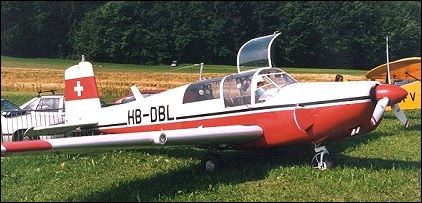|
| Saab flew in 1945 the prototype of the Saab-91 Safir, a three-seat cabin monoplane of cantilever low-wing configuration which had retractable tricycle landing gear and was powered by a 97kW de Havilland Gipsy Major 1C inline engine. Successful testing led to the first production version, the Saab-91A, which differed primarily by having the more powerful de Havilland Gipsy Major 10 engine. Swedish airforce interest in this aircraft as a primary trainer led to a prototype powered by a 142kW Avco Lycoming O-435-A flat-six engine, first flown on 18 January 1949. This was adopted by the Flygvapen as a standard trainer under the designation Sk 50, built by Saab with the same powerplant as the Saab-91B It could be equipped to carry guns, practice bombs or rockets, and served also with the air forces of Ethiopia and Norway; in a pure training sub-variant this version was also adopted by a number of European airlines.
The Saab-91C, first flown in September
having four-seat accommodation. The final production version was the Saab-91D, which introduced a number of improvements, including a new Avco Lycoming O-360-A1A engine, disc brakes and other advanced equipment that offered weight saving. When production ended a total of about 320 Safirs had been built, and examples had been sold to operators in some 20 countries.

| MODEL | Saab-91D Safir |
| ENGINE | 1 x Avco Lycoming O-360-A1A, 134kW |
| WEIGHTS |
| Take-off weight | 1205 kg | 2657 lb |
| Empty weight | 710 kg | 1565 lb |
| DIMENSIONS |
| Wingspan | 10.6 m | 35 ft 9 in |
| Length | 7.95 m | 26 ft 1 in |
| Height | 2.2 m | 7 ft 3 in |
| Wing area | 13.6 m2 | 146.39 sq ft |
| PERFORMANCE |
| Max. speed | 266 km/h | 165 mph |
| Ceiling | 5000 m | 16400 ft |
| Range | 1000 km | 621 miles |
 | A three-view drawing (800 x 732) |
| Tommy Anthonsen, e-mail, 11.11.2012 00:33 As a lucky owner of a SAAB 91D "Safir" (LN-MAZ ex PH-RLV)
for over twenty years I was a bit surprised to see HB-DBL
equipped with a three blade prop.
Modified with a bigger engine? reply |
| Brian Cloete, e-mail, 31.01.2012 18:07 How many of these aircraft is still flying? reply | | Johan Runfeldt, e-mail, 22.07.2011 18:21 It looks even more like the B� 181, and for good reason. The designer, A J Andersson worked for B�cker during the 1930s. reply |
| Karl, 21.07.2010 00:59 It looks like the Bf-108. reply |
|
Do you have any comments?
|
| 
COMPANY
PROFILE
All the World's Rotorcraft
|








 Johan Runfeldt
Johan Runfeldt
20
reply